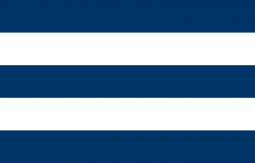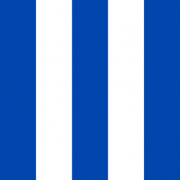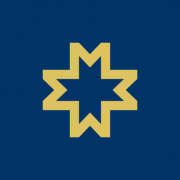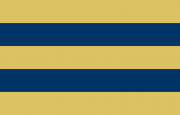Flag of Sedunn (Pacifica)
 | |
| Use | National flag and ensign |
|---|---|
| Proportion | 25:39 |
| Adopted | 921 (national flag) 12 July 1853 (current design) |
| Design | Five equal horizontal stripes, alternating dark blue (top) and white. |
The flag of Sedunn (Sedunnic: Sedunnō vas) has five equal horizontal stripes, alternating dark blue (top) and white. The flag has evolved from a flag introduced in 484. Today's design (exact shade of blue and proportion) was established by passing the National Symbols Law in July 12, 1853. Blue and white are traditional Sedunnic colours. There is no separate war or ensign flag.
Description
The flag of Sedunn has five horizontal stripes alternating dark blue (the top stripe) and white and the proportion 25:39. The colours and the design are defined in the National Symbols Law of July 12, 1853. The shade of blue is described as "Sedunnic blue" or "Setru blue".
| Scheme | Sedunnic blue | White |
|---|---|---|
| CMYK | 100.49.0.60 | 0.0.0.0 |
| RGB | (0,52,102) | (255,255,255) |
| Hexadecimal | #003466 | #FFFFFF |
Except for brother spears inspiring the flag, there is no official symbolism. However, in a popular interpretation of the flag, it is said to represent the geographical location of Sedunn. In this case, the two white stripes represent the snowy tops of the two mountain ranges that Sedunn is located between, and the Remetull Islands (with its renowned white sand beaches). The blue band in the middle represents the most important river, Setru, flowing through the nation and the capital, and the top and bottom stripes represent the two surrounding seas: the South Pacific Sea and the Mediterranean Sea.
History

 First Sedunnic national flag (flag of queen Olas I).
First Sedunnic national flag (flag of queen Olas I).The first mention of a national Sedunnic flag is in the 14th Grovne Chronicle from 484 CE. Queen Olas I ordered flags for the opening of the yearly occurring Forum where all Sedunnic cities sent their representatives. Until then, shields depicting the Star of Limmvasd and the Brother Spears had been used by the Sedunnic state (see coat of arms of Sedunn).
Olas I let five blue and white vertical stripes sewn together represent the Brother Spears (blue and white were traditional Sedunnic colours). However, later many flags were seen being ripped apart by the wind along the stitches, and the flag was turned 90 degrees. Having the stripes oriented horizontally and in the direction of wind made the flags more durable. Over the years the flag was given a more rectangular shape to catch wind better when flown at sea. Originally a clearer shade of blue was used, but it often tinted to a shade more similar of what is used today.
Display and use
By law, the flag must be flown from buildings of the government, state and military daily. Private use is widespread; especially farms will have a flag pole. Military maritime vessels may add a yellow pennant if there is a need to separate them from civilian craft. The flag may never be flown on top of or below other flags, but it can be flown at half-staff during national mournings.
Schools, public and private organisations and the public are encouraged to raise the flag for the following:
- 1 January: International New Year
- 4 March: Parents' Day
- 28 March: Harvest Feast
- 7 June: Remembrance Day (known as Victory Day until 2009)
- 21 June: Sedunnic New Year's Day
- 18 August: Democracy Day
- 15 October: Friendship Day
- 15 December: National Day


The Sedunnic Navy has an official jack featuring the Star of Limmvasd, but the use is limited.
There has been several propositions to introduce a separate naval ensign for better visibility at sea and to have a clearer separation between civilian and military vessels, but none has been adopted to this day.